Wildlife in the Garlic Field
Tips for Attracting Wildlife
To attract wildlife to your backyard or farm think about what animals and birds need:
Food: Try to have a good mix of plants and shrubs that provide seeds and fruit throughout the year. Native plants are often a good choice. Pick plants with berries and flowers with nectar to attract birds, small mammals and butterflies.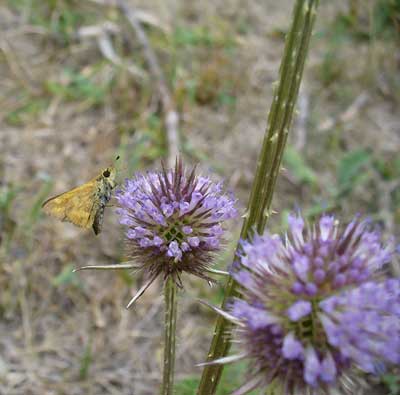
Picture: Native plants provide food for wildlife big and small.
Water: Provide a source of water. Animals and birds are attracted to a consistent supply of safe liquid for drinking and bathing.
A Nontoxic Environment: Don't spray your land or yard with insecticides or other chemicals to kill bugs and weeds. Many birds and small mammals eat insects. Wildlife can also be harmed by chemical use.
If you have to spray try to pick a time and a chemical that will be least disruptive to wildlife and pollinators. For example, don't spray plants in bloom; that results in much more bees being killed when they try to visit the flowers. It would be better to wait until after the plants or shrubs have finished blooming. Try not to spray when your shrubs or trees contain berries which wildlife use as food. Choose pesticides with less toxicity; organophosphorous, carbamate and neonicotinoid insecticides are toxic to bees and birds.
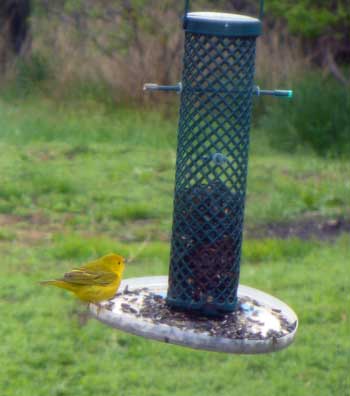 Picture: Many insect eating songbirds, such as this yellow warbler, are also attracted to black sunflower seeds. Yellow warblers help control pest insects, such as caterpillars, on trees and shrubs.
Picture: Many insect eating songbirds, such as this yellow warbler, are also attracted to black sunflower seeds. Yellow warblers help control pest insects, such as caterpillars, on trees and shrubs.
Many people who love birds choose not to spray or plant treated seeds. Neonicotinoid pesticides kill more than bees, they are also dangerous for songbirds and aquatic systems. A report commissioned by American Bird Conservancy (ABC) stated that one corn kernel or wheat seed treated with the neonicotinoid insecticide Imidacloprid can kill a average sized songbird. A tenth of that amount can affect a songbird's reproductive ability. For more information see ABC's report, "The Impact of the Nation's Most Widely Used Pesticide on Birds" American Bird Conservatory March 2013 by Dr. Pierre Mineau and Cynthia Palmer. This 100 page report outlines the problem and the danger to our flying friends. Some pesticides covered in the report were imidacloprid, clothianidin, thiamethoxam, and other neonicotinoid insecticides.
Avoid Products Containing Neonicotinoids: Read the product label and avoid using off-the-shelf neonicotinoid insecticides in your garden or around your home. Products to avoid include those containing acetamiprid, clothianidin, imidacloprid, dinotefuran, and thiamethoxam as active ingredients. For a comprehensive list of products containing these harmful insecticides please see appendix A (page 26) in Gardeners Beware: Bee-toxic Pesticides Found in "Bee-Friendly" Plants Sold at Garden Centers Nationalwide.
Use Safe Nursery Plants: 'Bee' careful about where you buy your nursery plants: A recent study coauthored by the Pesticide Research Institute, showed that 7 out of 13 samples of garden plants sold at nurseries contained neonicotinoid pesticides lethal to bees. Ironically, some of the treated plants were varieties marketed as bee friendly! For more on this topic see this report commissioned by Friends of the Earth and written by Susan Kegley, PHD, Tiffany Finck-Haynes and Lisa Archer: Gardeners Beware 2016 Bee-toxic Pesticides Found in "Bee-Friendly" Plants Sold at Garden Centers Nationalwide.
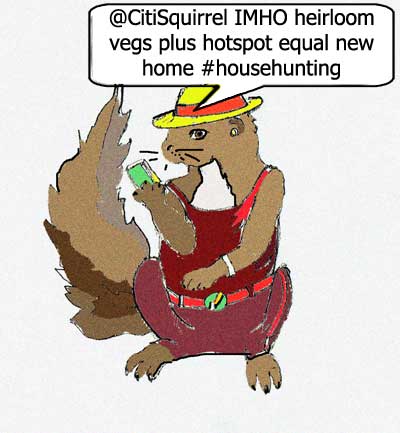 Shelter: Brush piles, hollow logs, stone piles or walls, perennial plants, dense vegetation, trees and shrubs all provide natural shelter for wildlife. Just like you wouldn't want to live on a concrete pad with no walls or roof to shelter you, wildlife doesn't want to live in a open area like a flat manicured lawn. Layer plants to provide different types of spaces; this means plan your landscaping to have tall, medium and short plants and trees.
Shelter: Brush piles, hollow logs, stone piles or walls, perennial plants, dense vegetation, trees and shrubs all provide natural shelter for wildlife. Just like you wouldn't want to live on a concrete pad with no walls or roof to shelter you, wildlife doesn't want to live in a open area like a flat manicured lawn. Layer plants to provide different types of spaces; this means plan your landscaping to have tall, medium and short plants and trees.
You can also build or buy bee and bird houses!
Diversity: More plant diversity also means more wildlife. Animals and birds appreciate a unique habitat with lots of places available for nesting, eating and just hanging out.
Technology: Smart phone rechargers and free WiFi hotspots will attract hipster wildlife. Expect a clambering for free range organic acorns to follow.
Wildlife in the Garlic Field
At Grey Duck Garlic farm we believe in farming in a sustainable fashion. We grow our garlic organically because it is better for the land and for your health. See why we don't use chemicals here.
Picture: A Kildeer parent attempts to distract us away from its nest with a well played 'death scenes'.
One benefit of farming organically is a large ecosystem of wildlife, birds and insects. Often wildlife take over our garlic field and surrounding areas. This spring, after planting our green cover 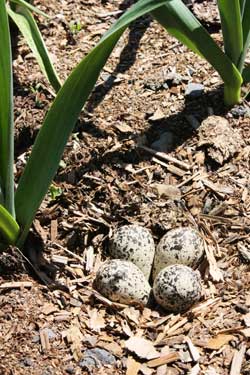 crop, Jane was amused to note a flock of chickens (luckily hers), several geese, seven pheasants, a few ducks and a wild turkey pair helping themselves to the 'free' grain I had handily sprinkled out for them.
crop, Jane was amused to note a flock of chickens (luckily hers), several geese, seven pheasants, a few ducks and a wild turkey pair helping themselves to the 'free' grain I had handily sprinkled out for them.
Picture: A well camouflaged Kildeer nest with four speckled eggs.
As we weeded one spring, two small theatrical birds tried to district us with loud cries and dramatic death scenes. Kildeer use amateur theatrics to lead potential predators away from their shallow nests. Often they pretend to have a broken wing or throw themselves on their backs and let their wings flop in convincing convulsions. Some of the birds are better actors than others. These birds were ready for their academy award.
Since we didn't want to step on the Kildeer nest we needed to find it. This is easier said than done since nests and eggs are very well camouflaged. To triangulate the nests position, we let the birds lead us in different directions. The direction they didn't lead us in was where the nest was located.
Walking gingerly, Susan finally found the nest nestled in the garlic plot with four speckled eggs. Kildeer nests are just depressions in the soil so the eggs don't roll away from their parents.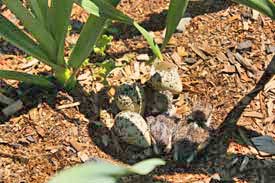
Pictures: Baby Kildeer hatching. If you look closely you can see two little chicks by the two eggs in the top photo and three chicks in the bottom photo. The baby 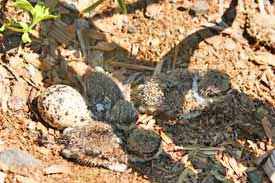 chicks are as well camouflaged as the eggs. All four eggs hatched within a few hours. Once out of the egg, the little birds are quickly up and running after their parents.
chicks are as well camouflaged as the eggs. All four eggs hatched within a few hours. Once out of the egg, the little birds are quickly up and running after their parents.
Later that week we were lucky enough to be in the field weeding when the babies started hatching. As the chicks hatch the parent birds remove the old egg shells. Within a few hours all of the chicks were dried off and following their parents. The old 'nest' was abandoned.
References:
- Mineau P and Palmer C. The Impact of the Nation's Most Widely Used Pesticide on Birds. American Bird Conservancy. 2013. Full text.
